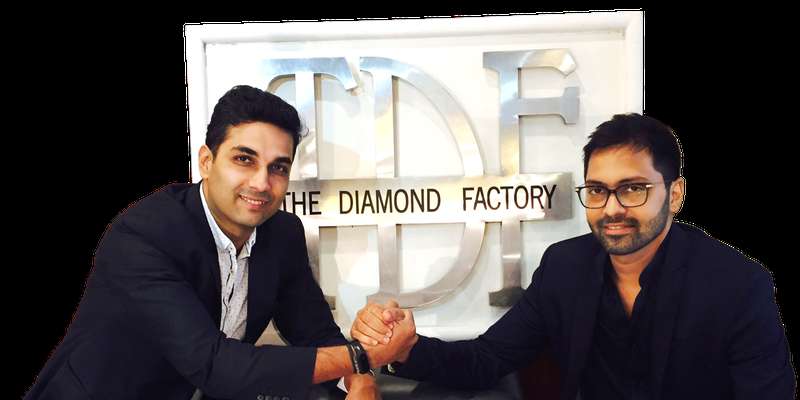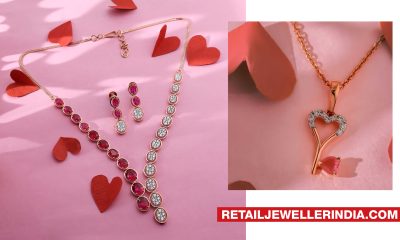RJ Market Watch
Starting from a garage, here’s how these school friends built a Rs 75 Cr turnover jewellery brand

40 year-old-entrepreneurs Gautam Singhvi and Prasanna Shetty have been inseparable friends since their schooldays in Mumbai. Joining the same college, they started organising events, and, realising their flair for management, wished to do something big on their own.
Gautam’s family was in the jewellery business, and the friends thought to leverage the family’s expertise, knowledge, and connections. In 1999, the friends started supplying gold coins, chains, and small orders to wholesalers and retailers.
But Gautam wasn’t initially fated to be an entrepreneur. His father, a local gold jeweller, believed the entire family should take care of the store. “Ever since I was in school, I used to go to my father’s jewellery store and observe. The plan was to join the store full-time after graduating from college,” Gautam tells SMBStory.
Gautam joined the business after graduating, and, wanting to modernise the business, said he wanted to start selling diamond jewellery and try new things. “These ideas were not possible to execute within the family business as my father was unsure of the expansion plan I had. So, he encouraged me to venture out on my own and try my hand at selling diamond jewellery,” recalls Gautam.
He and Prasanna also experimented with real estate, selling, buying, and investing in property. Says Prasanna, “We were moonlighting as small-time real estate and jewellery entrepreneurs. Gautam continued to work with his father, and, in our small jewellery wholesale venture, he introduced diamond jewellery. I, meanwhile, did a management course and got into a full-time corporate job.”
While the duo worked hard at their fulltime gigs, they noticed their friends and family preferred to buy diamond jewellery directly from them rather than from a brand they supplied to. “We realised that retail could be more profitable than our wholesale model,” says Prasanna, adding, “To test this, we set up a boutique diamond jewellery retail outlet in a small garage in Bandra in 2008.”
Seeing their initial promising results, Prasanna quit his job, and the friends came together and deep-dived into this venture. The Bandra outlet was the first The Diamond Factory (TDF) store, a jewellery brand that has grown into a Rs 75 crore business with 100+ employees in the past 10 years.
The brand specialises in retailing diamond and gold jewellery along with guttapusalu, kundan, temple, and uncut jadau jewellery, as well as other intricate hand-crafted pieces in contemporary designs. “We started in Bandra, which is a jewellery hub. We had a lot of competition. So we wanted to make unique designs,” says Gautam.
A cost-conscious approach
TDF’s success cannot be put down to just one or two reasons. It was a result of several factors coming together, such as the overall market growth, its high quality and designer jewellery, the founders’ cost-conscious approach to pricing, and their experience in jewellery and marketing.
India is considered the hub of the global jewellery market and is the world’s largest centre for diamond cutting and polishing. IBEF data estimates the $75 billion jewellery market to reach $100 billion by 2025.
Low production costs constitute another factor catalysing this growth, and TDF has priced its products accordingly in a bid to capture some of the market away from the more established players. Gautam explains: “Generally, we ensure that our product pricing is about 30 to 35 percent lower than the big corporates and the national brands and about 15 to 20 percent lower than the general local stores. Due to transparency in accounting and a provision of an accurate breakup of costs provided to customers, we have built a positive recall value and a multitude of repeat clients.”
TDF’s pricing is dependent on the prevailing gold rates, diamond rates, and manufacturing costs. The pricing varies if the product has a setting of coloured stones. TDF’s products are made at its own factory in the industrial area of Dahisar, a preferred location as the overhead expenditure there is lower than in major cities. According to Gautam, another reason for choosing this location was the easy availability of a skilled workforce. The location makes it more viable for the company to acquire large spaces and employ more karigars working collectively, which has facilitated an increase in production.

The co-founder adds that the unit is dedicated to manufacturing jewellery of high quality, based on traditional craftsmanship and modern technology. “It is a vertically-integrated business model, from in-house design and manufacturing to marketing and direct distribution in our retail stores,” he says.
Gautam and Prasanna claim their products come with a certification of diamonds and hallmarked quality gold. “In the coming years, whenever the gold or diamond rate goes up or down, clients will be informed what their goods/products are worth,” adds Gautam.
After seeing good sales numbers at its Bandra outlet, the company now has three more outlets in Andheri, Vashi, and Mangaluru. According to the founders, TDF has become one of the country’s fastest-growing brands in diamond jewellery.
Market share and future plans
To date, no outside investors have funded TDF, Gautam says, adding that they have kept the business model asset-light and invested Rs 50 lakh each of their own money in the business. The founders took a bank loan in 2011 to open more stores and scale production.
TDF sources its raw materials such as loose diamonds from big names like Rio Tinto and Debeers. These diamonds are delivered to TDF via a large site-holder in India. Explains Gautam, “This ensures that the diamonds used in the jewellery are real, natural, and ethically sourced. We put a lot of emphasis on the cut of the jewellery, and are very specific in choosing the cut part that ensures great light and luster in the diamonds and jewels forever. This is the USP of our brand.”
The brand also offers multi-use products, such as rings that can be used in pendants, necklaces, etc. “Anyone that drives a Honda City and above is our target client. Their age can range from 18 to 55, and they are middle or upper class,” says Prasanna.

According to him, TDF’s jewellery can be classified as day-to-day wear and occasional wear, and these are marketed through exhibitions in Bengaluru, Mangaluru, and Mumbai, among other cities.
“We do a lot of retail activities in residential societies. We also do social media marketing and presentations in companies. In the past one or two years, we have spent a lot on digital. Ad spends are high during events and seasons,” he adds.
The founders are mindful of the struggles they faced initially and they hope that the business outlook continues to improve.
“Competition has always been high and people who noticed us were already loyal to other brands. Our challenge was establishing ourselves as a brand. Our unique designs and transparency helped us, but then, after the demand increased, our inventory couldn’t keep up,” recalls Prasanna.
The bank loan helped TDF meet demand and increase production. After opening more stores, TDF slowly started functioning like a corporate and less like a small business, they say. Going forward, TDF aims to improve its systems and processes, and also continue building its brand.
“We resort to a host of BTL activities, exhibitions, and digital marketing in Mumbai apart from other cities. Through the franchise mode, we are coming up with more stores, not just in Mumbai but also in the outskirts. We have been conducting exhibitions in many other cities and will soon be expanding our brand to metropolitan regions,” says Gautam.
Courtesy: YOURSTORY





 Wide Angle1 month ago
Wide Angle1 month agoIndia has overtaken China to become second largest diamond market: De Beers CEO Al Cook

 Daily News1 month ago
Daily News1 month agoUS-based private equity firm Advent International to acquire Orra Fine Jewellery, say media reports

 Exclusive2 months ago
Exclusive2 months agoThe House of Rose debuts in Mumbai with a 21,000 sq. ft. experiential concept space showcasing fine jewellery and luxury watch brands

 Wide Angle1 month ago
Wide Angle1 month agoEminent jeweller Viren Bhagat sets up first global boutique in London’s Mayfair
























